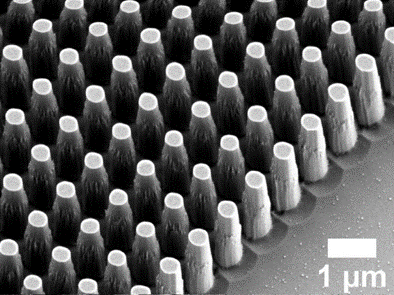
round pillars
polarization insenstive
polarization insenstive
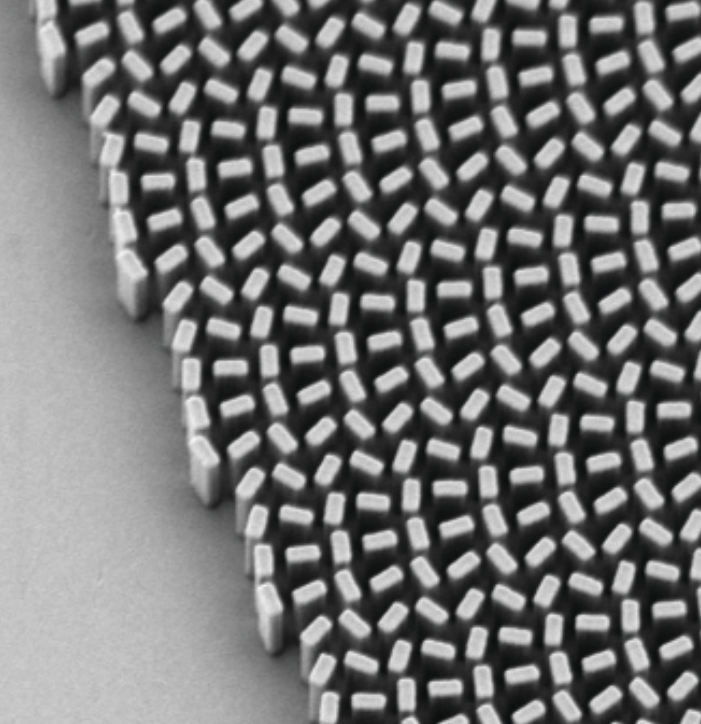
rectangular pillars
for circular polarization
for circular polarization
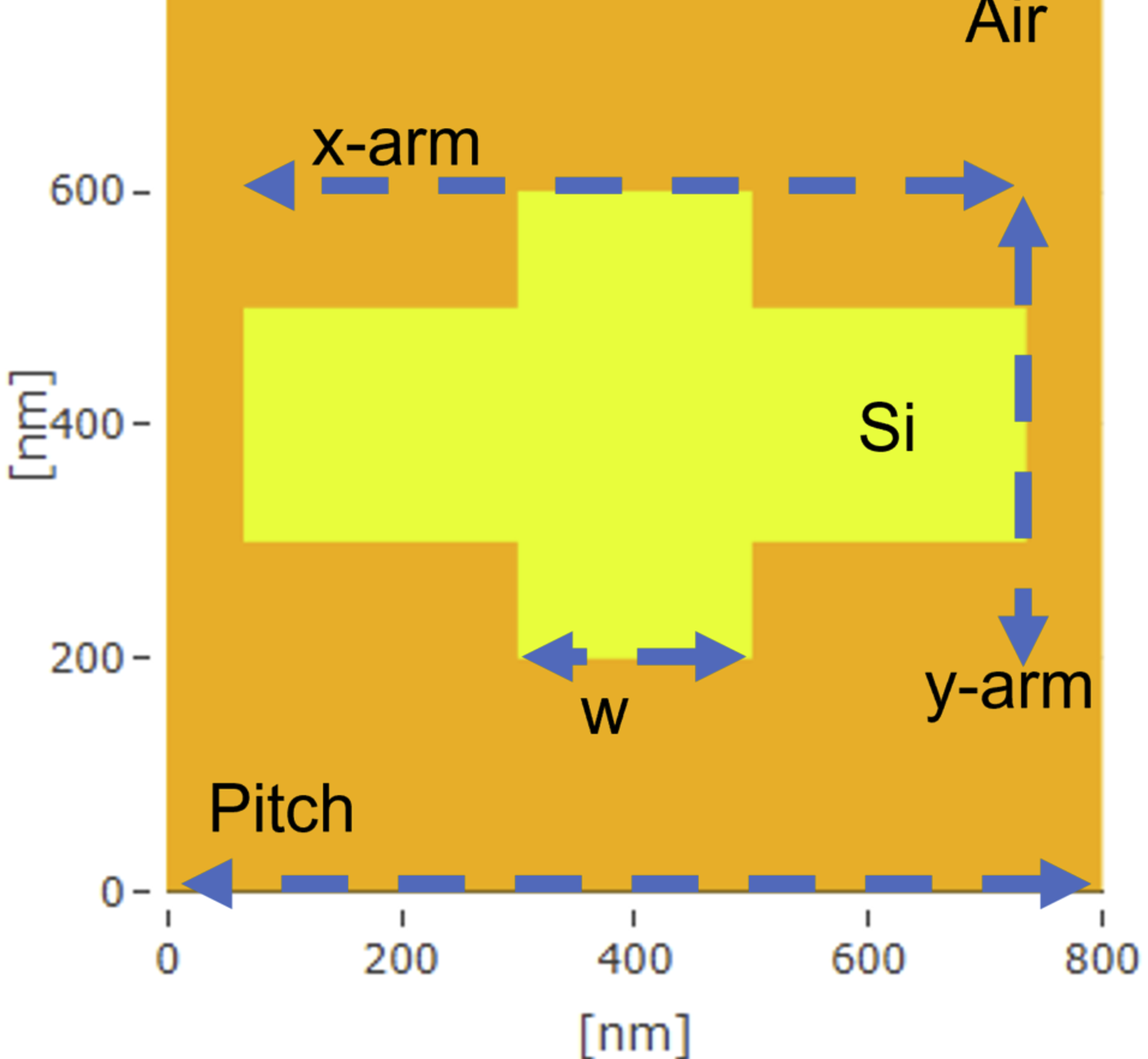
cross-type pillar
x-arm length TM polarization
y-arm length TE polarization
x-arm length TM polarization
y-arm length TE polarization
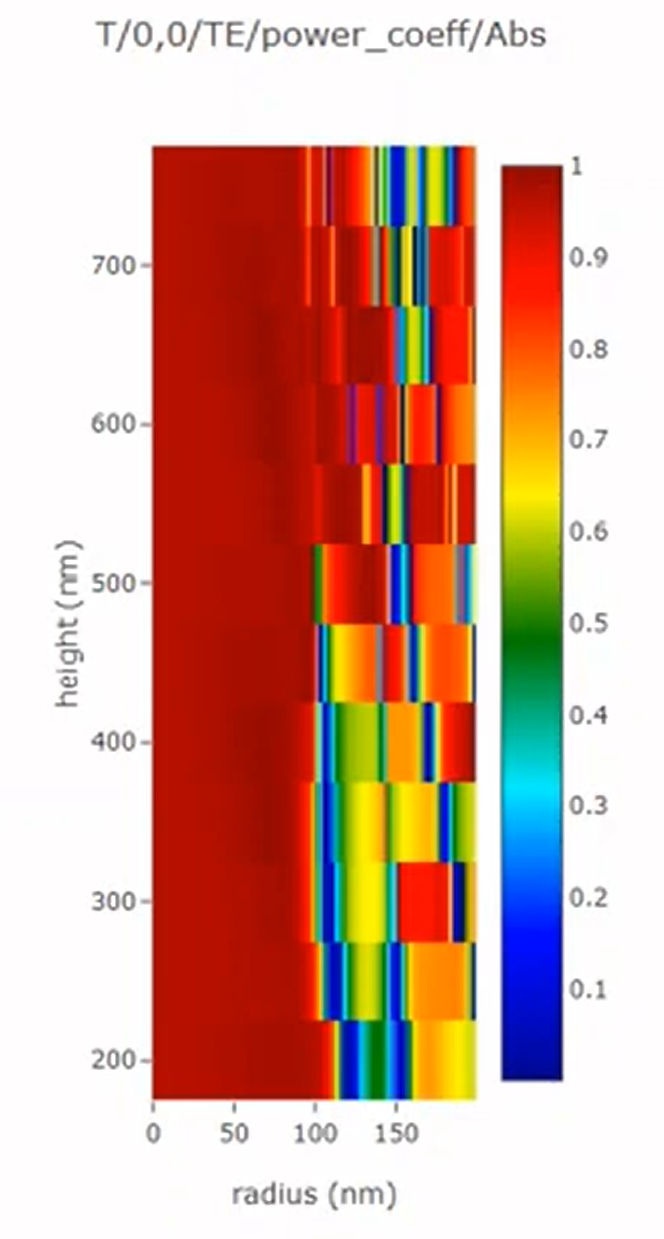
heat map plot showing
transmission vs pillar height
calculated using RCWA
Pillar height selected for
good transmission across
pillar radii

phase vs pillar radius
calculated using RCWA
Pillars from 0-to-2pi phase
are selected and saved in
a meta-atom library
to use as building blocks
for metasurface layout
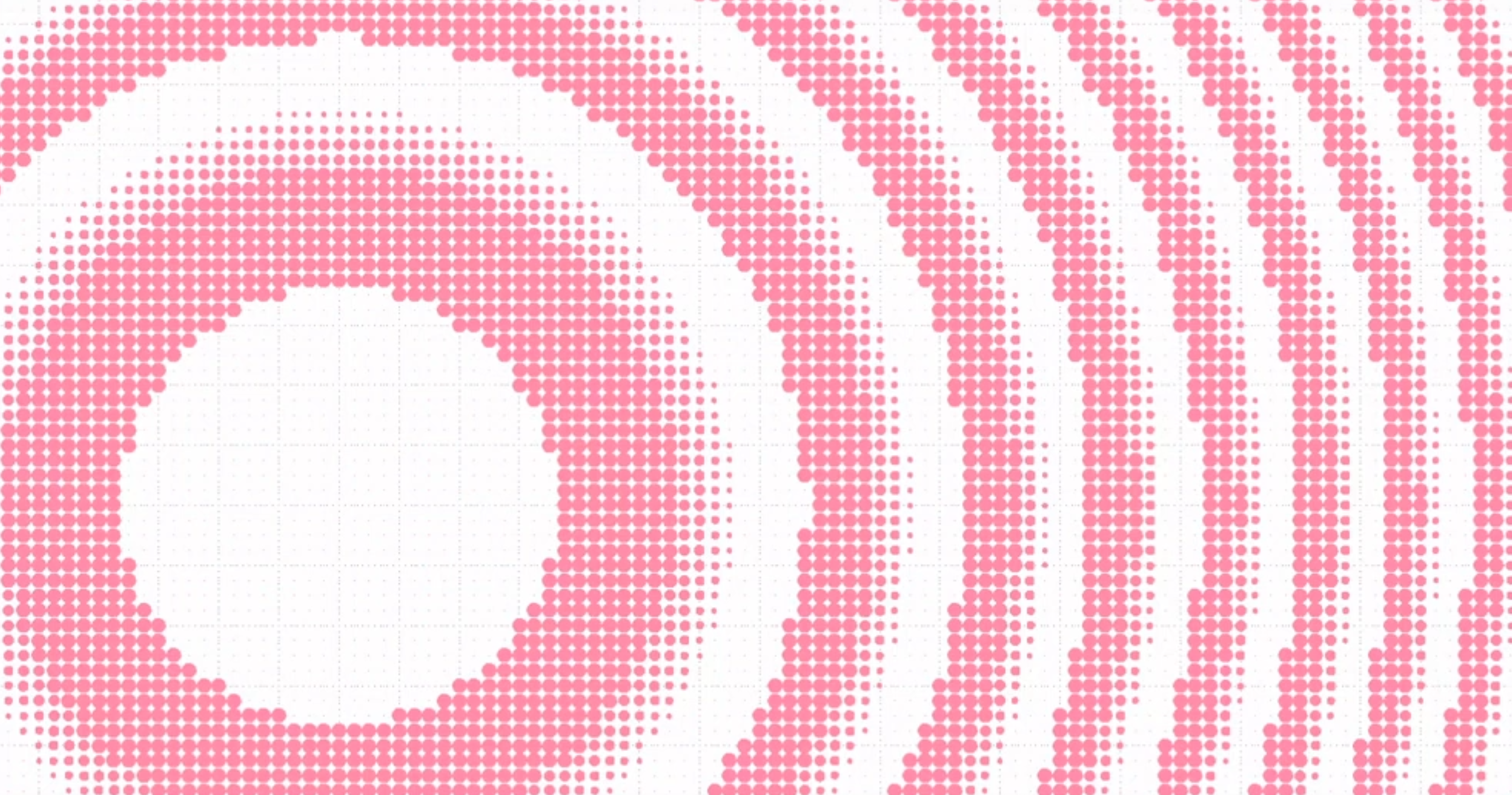
englarged GDS mask showing
meta-atoms placed at positions
in the metasurface to minimize
target wavefront error
meta-atoms placed at positions
in the metasurface to minimize
target wavefront error
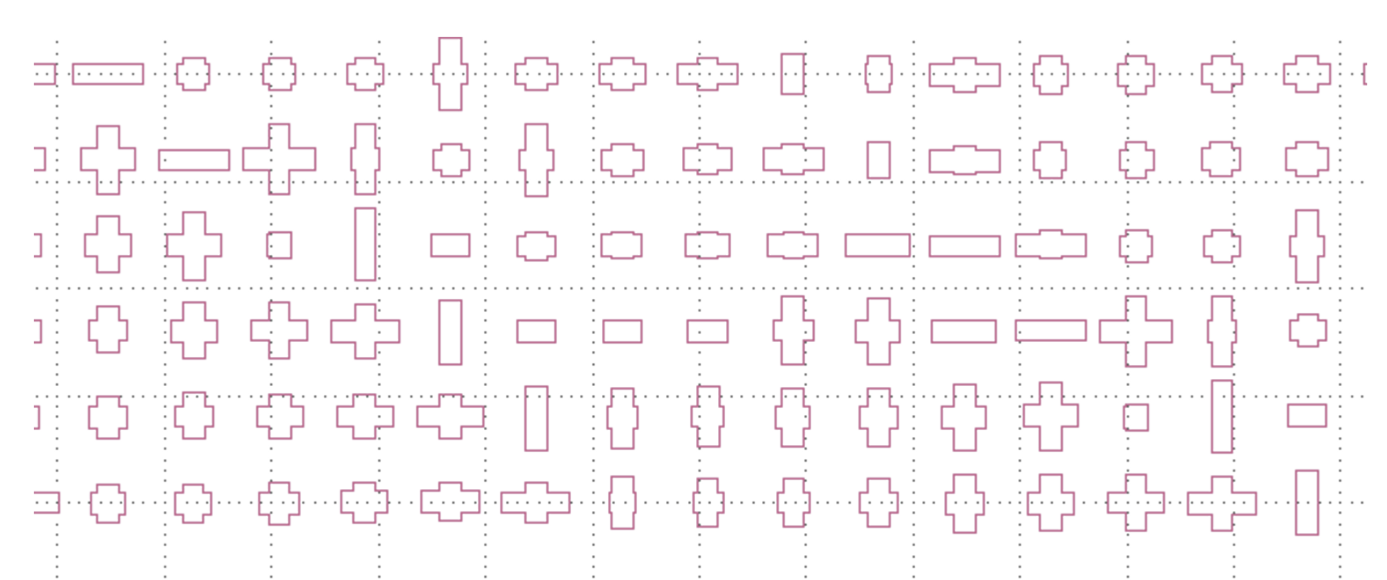
rectangular and cross-shape
meta-atoms placed at each
position on the surface
according to the phase with
the lowest target wavefront
error
meta-atoms placed at each
position on the surface
according to the phase with
the lowest target wavefront
error

GDS mask showing metasurface
layout with weighted optimization
to split TE and TM polarization
Metalenses are increasingly replacing conventional lenses for imaging, sensing and display applications, because they are flat lenses with many degrees of design freedom that can simplify and reduce the size of optical systems.
Metalenses can control the amplitude, phase and polarization of light. They can be designed for large FOV, achromatic correction, polarization sensing and control and complex wavefront patterns.
There are several ways to fabricate metalenses, depending on the application, the materials and the production facilities.
E-beam lithography by scanning an electron beam is typically used for low-volume laboratory applications.
Photo lithography, using a mask, similar to semiconductor manufacturing, is for high volume applications.
Nano-imprint lithography is a pattern transfer method which mechanically creates a pattern in a soft material, such as a polymer. The material is then cured by UV light.
Features of PlanOpSim MetaCell program module
Create subwavelength pillars and meta-atom pillar groups.
Metasurface pillar shapes included:
round - polarization insensitive
rectangular - polarization sensitive by rotation
cross - more polarization control by rotation and x, y dimensions
Full wave RCWA Maxwell solver to calculate the phase and transmission
of meta-atoms
Plot heat map showing transmission (in red) vs pillar height and radius
Choose pillar height for maximum transmission across a range
of pillar sizes and for practical fabrication height.
Plot phase vs pillar radius to select pillars from 0-to-2pi phase
to include in a meta-atom pillar group
Store meta-atom pillar groups in a library for convenient metasurface
layout, as described in the next section on the MetaComponent
program module.
The library can contain meta-atom pillar groups with different pillar
shapes for designing complex, multifunction wavefront targets,
for polarization control and for achromatic design by dispersion
engineering.
Ask us for use cases describing polarization control and dispersion
engineering.
Contact us to request RCWA vs FDTD speed and accuracy comparison.
Features of PlanOpSim MetaComponent program module
The MetaComponent program is for importing near-field and far-field
targets, conveniently laying out metasurface structures using the
meta-atom library created in the MetaCell program, exporting GDSII
fabrication files and exporting metasurface designs to Zemax.
Near-field design - two ways:
Input Zemax wavefront surface response (binary2 surface)
Input near-field phase as an analytical expression, in a
Python script to create a customized wavefront
Far-field design - and IFTA
For far-field design a target pattern can be imported, such as a JSON
image file.
Iterative Fourier Transform Algorithm (IFTA) is used to create
metasurface phase designs from a far-field pattern.
IFTA starts by creating a random phase distribution
in the near-field, based on far-field amplitude input.
The projected pattern is evaluated against the target, and each
iteration improves the phase design until a desired pattern
is developed.
It takes PlanOpSim just seconds to develop, evaluate and improve
mutiple metasurface phase designs.
Parameter sweep
The Parameter Sweep in PlanOpSim is used to optimize designs for
best performance, based on design criteria, and for fabrication
tolerance analysis.
Minimum and maximum ranges for each parameter can be
specified, as well as the number of steps to vary in each range.
Parameters can be varied linearly or randomly.
The Parameter Sweep also makes it easy to see how performance
changes when varying such parameters as wavelength
and angle of incidence.
Results, including spot size, spot location and wavefront can be
shown quickly, and they can be viewed dynamically using a
separate slider bar for each variable.
Export GDSII fabrication files
The finished metasurface design is used to export a GDSII
fabrication file.
Shown on the left are three examples of GDSII masks.
round polarization-insensitive pillars
both rectangular and cross pillars
weighted optimization to split TE and TM polarization
and focal spot locations
Click on each image to enlarge it.
Zemax Import
Importing Zemax binary 2 files into PlanOpSim for metalstructure
applications extends Zemax ray tracing to fully vectorial physical
optics modeling and physical structure designs.
Types of User Licenses
PlanOpSim software is available for online operation or with a dongle for
local operation.
User licenses can either be permanent or renewable subscriptions.
Subscription user licenses can reduce initial cost, offer longer, more
thorough software evaluations or provide practical solutions
for short-term projects.
Subscription user licenses can be converted to permanent licenses
layout with weighted optimization
to split TE and TM polarization
PlanOpSim Metalens Simulation and Design Software
Metalenses are increasingly replacing conventional lenses for imaging, sensing and display applications, because they are flat lenses with many degrees of design freedom that can simplify and reduce the size of optical systems.
Metalenses can control the amplitude, phase and polarization of light. They can be designed for large FOV, achromatic correction, polarization sensing and control and complex wavefront patterns.
There are several ways to fabricate metalenses, depending on the application, the materials and the production facilities.
E-beam lithography by scanning an electron beam is typically used for low-volume laboratory applications.
Photo lithography, using a mask, similar to semiconductor manufacturing, is for high volume applications.
Nano-imprint lithography is a pattern transfer method which mechanically creates a pattern in a soft material, such as a polymer. The material is then cured by UV light.
Easy to use
Optical engineers can work efficiently with PlanOpSim metalens simulation and design software,
because it was developed specifically for metalens applications. The workflow is logical and intuitive for metalens
simulation and design.
PlanOpsim is the only optical design software that includes a graphical user interface for all the steps in designing metalenses. This includes: creating meta-atoms and substrate structures, storing them in libraries, creating near-field or far-field targets, laying out metasurfaces, optimizing final designs and exporting GDSII fabrication files.
It is easier to learn and use than software with scripts or a combination of scripts and a graphical interface.
Contact us to request a competitive workflow comparison
Both new and experienced metalens designers can easily modify configurations (e.g. materials, pillar shapes, dimensions, incident light) for performance comparison, and they can dynamically change multiple variables for optimization, tolerancing and manufacturability.
PlanOpSim is your source for both software and expert support by a team that specializes in metalens design and applications.
PlanOpsim is the only optical design software that includes a graphical user interface for all the steps in designing metalenses. This includes: creating meta-atoms and substrate structures, storing them in libraries, creating near-field or far-field targets, laying out metasurfaces, optimizing final designs and exporting GDSII fabrication files.
It is easier to learn and use than software with scripts or a combination of scripts and a graphical interface.
Contact us to request a competitive workflow comparison
Both new and experienced metalens designers can easily modify configurations (e.g. materials, pillar shapes, dimensions, incident light) for performance comparison, and they can dynamically change multiple variables for optimization, tolerancing and manufacturability.
PlanOpSim is your source for both software and expert support by a team that specializes in metalens design and applications.
Two program modules.
PlanOpSim software includes two program modules.
The MetaCell program module is for creating pillar structures and substrates, creating meta-atom groups from pillars, storing meta-atom groups in a library for metasurface layout.
The MetaComponent program module is for creating a near-field or far-field wavefront target, creating metasurface designs, optimizing the final design, laying out the metasurface using a meta-atom group from the library and exporting a GDSII fabrication file.
The MetaCell program module is for creating pillar structures and substrates, creating meta-atom groups from pillars, storing meta-atom groups in a library for metasurface layout.
The MetaComponent program module is for creating a near-field or far-field wavefront target, creating metasurface designs, optimizing the final design, laying out the metasurface using a meta-atom group from the library and exporting a GDSII fabrication file.
Features of PlanOpSim MetaCell program module
Create subwavelength pillars and meta-atom pillar groups.
Metasurface pillar shapes included:
round - polarization insensitive
rectangular - polarization sensitive by rotation
cross - more polarization control by rotation and x, y dimensions
Full wave RCWA Maxwell solver to calculate the phase and transmission
of meta-atoms
Plot heat map showing transmission (in red) vs pillar height and radius
Choose pillar height for maximum transmission across a range
of pillar sizes and for practical fabrication height.
Plot phase vs pillar radius to select pillars from 0-to-2pi phase
to include in a meta-atom pillar group
Store meta-atom pillar groups in a library for convenient metasurface
layout, as described in the next section on the MetaComponent
program module.
The library can contain meta-atom pillar groups with different pillar
shapes for designing complex, multifunction wavefront targets,
for polarization control and for achromatic design by dispersion
engineering.
Ask us for use cases describing polarization control and dispersion
engineering.
Contact us to request RCWA vs FDTD speed and accuracy comparison.
Features of PlanOpSim MetaComponent program module
The MetaComponent program is for importing near-field and far-field
targets, conveniently laying out metasurface structures using the
meta-atom library created in the MetaCell program, exporting GDSII
fabrication files and exporting metasurface designs to Zemax.
Near-field design - two ways:
Input Zemax wavefront surface response (binary2 surface)
Input near-field phase as an analytical expression, in a
Python script to create a customized wavefront
Far-field design - and IFTA
For far-field design a target pattern can be imported, such as a JSON
image file.
Iterative Fourier Transform Algorithm (IFTA) is used to create
metasurface phase designs from a far-field pattern.
IFTA starts by creating a random phase distribution
in the near-field, based on far-field amplitude input.
The projected pattern is evaluated against the target, and each
iteration improves the phase design until a desired pattern
is developed.
It takes PlanOpSim just seconds to develop, evaluate and improve
mutiple metasurface phase designs.
Parameter sweep
The Parameter Sweep in PlanOpSim is used to optimize designs for
best performance, based on design criteria, and for fabrication
tolerance analysis.
Minimum and maximum ranges for each parameter can be
specified, as well as the number of steps to vary in each range.
Parameters can be varied linearly or randomly.
The Parameter Sweep also makes it easy to see how performance
changes when varying such parameters as wavelength
and angle of incidence.
Results, including spot size, spot location and wavefront can be
shown quickly, and they can be viewed dynamically using a
separate slider bar for each variable.
Export GDSII fabrication files
The finished metasurface design is used to export a GDSII
fabrication file.
Shown on the left are three examples of GDSII masks.
round polarization-insensitive pillars
both rectangular and cross pillars
weighted optimization to split TE and TM polarization
and focal spot locations
Click on each image to enlarge it.
Zemax Import
Importing Zemax binary 2 files into PlanOpSim for metalstructure
applications extends Zemax ray tracing to fully vectorial physical
optics modeling and physical structure designs.
Types of User Licenses
PlanOpSim software is available for online operation or with a dongle for
local operation.
User licenses can either be permanent or renewable subscriptions.
Subscription user licenses can reduce initial cost, offer longer, more
thorough software evaluations or provide practical solutions
for short-term projects.
Subscription user licenses can be converted to permanent licenses
To contact HMS Technology Sales for more information
click here